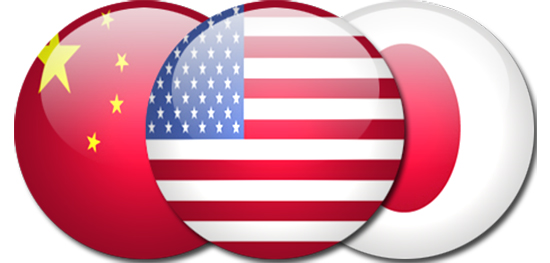As the most influential triangle in the world, China-United States-Japan relations have appeared tricky lately.

Some in Japan used to believe that the China-US relationship is the decisive factor in the China-US-Japan triangle: When the China-US relationship is stable, both China-Japan and Japan-US ties will be stable; when China and the US don’t get along, neither will China and Japan, nor Japan and US. There also was the view that changes in each of the three’s own policies and orientations have greater impacts on bilateral ties in the triangle.
From the US perspective, the year 2010 was a critical threshold. First, China’s GDP surpassed that of Japan’s. It is only a matter of time before China will surpass the US in terms of size of the economy. Whether this would lead to a “transfer of power”, however, depends on whether there will be changes in the geopolitical structure on the west coast of the Pacific that support “rights switch”. Second, that year in East Asia, five FTA’s were signed between and among China, Japan, South Korea, India, Australia and the Association of Southeast Asian Nations, with ASEAN at the center. That meant the outline of an East Asian commonwealth had taken shape that incorporates China, Japan, South Korea, India and Australia as partners, but excludes the US,that may arise as the times require.
From the US perspective in particular, this potential East Asian commonwealth contains a currency cooperation mechanism – a “multilateral framework” in the form of the “Chiang Mai Initiative” that would engage in currency swap. The US has been against any “multilateral framework” in East Asia. The Chiang Mai Initiative originated in the wake of the 1997 East Asia currency crisis, when Japan urged the independent launch of a $100-billon “Asian Monetary Fund” (Japan’s foreign exchange reserve was less than $300 billon then). After being throttled by Robert Rubin and Lawrence Summers, the idea was reborn at the ASEAN plus China, Japan, Korea finance ministers meeting in the form of a 10+3 currency swap agreement. It took the initial form of “bilateral swap” under a multilateral framework, and the voting mechanism was based strictly on a “one country, one vote” principle, to which the US displayed “benign neglect”. The US had not appeared upset until in 2005 when the Japanese Ministry of Finance began to push for its multilateralization, and even attempted to revive the AMF.
In 2009, the new Obama administration staged a high-profile return to the ASEAN, putting forward a US version of the “Mekong Cooperation Initiative”, lifting sanctions against Myanmar, which overlapped Japan’s five-nation regime. Washington’s move threatened Japanese dominance. In 2005 during the Busan APEC, the US government had already proposed forming a political, economic, security and social commonwealth with the ASEAN in 10 years. The “ASEAN economic commonwealth” started in 2015. Japan does not seem to be able to dictate what role the US plays and what impact it may have.
Driven by the Obama administration, the TPP has not only pulled four member states out of the East Asian commonwealth, but has also led Japan to voluntarily take part in the US-led TPP, accomplishing deconstruction of the East Asian commonwealth. Japan has lost conditions for dominating East Asian integration, and its long-standing sense of system superiority is fading fast.
The possibility of China and Japan forming a regional commonwealth on the basis of common interests has thus been circumvented by the US. A systemic geopolitical risk concerning global affairs and currency regimes has hence been eliminated.
Yet the US still faces another risk, i.e. the risk of regional instability resulting from unstable China-Japan relations. If since 2010 the China-US and Japan-US relationships in the China-US-Japan triangle have been “solid-line relations”, the China-Japan relationship has been “dashed-line relations”. This is not an actual “triangle”, and can’t be stable. The subsequent instability in the region doesn’t serve US Asia-Pacific strategy.
A thaw in China-Japan ties will be another hard nut for the US to crack. In 2016, China and Japan will respectively host a G20 and G7 summit, whose themes will be about “global affairs” and the global governance regime. Once China and Japan support each other, it might be impossible for the US to dictate the topics of discourse. The US may thus find itself in an embarrassing position over how to face the China-and-Japan-dominated discussion about global system reform and subsequent changes. By sending naval vessels on “freedom of navigation” operations in the South China Sea, the US has already shown its ambivalence over China-Japan relations.
The US is obviously acting this way with a guilty conscience, thanks to its economic fragility, financial unsustainability, and US dollar shortage. World economic scale expands rapidly under the background of globalization, while the US dollar can’t provide sufficient liquidity. Which means the systemic pillars of the dollar regime will lose legitimacy, as well as universal basic functions. Policy moves in China or Japan will affect China-US, Japan-US, even China-Japan relations. It is thus a common subject for the three countries to approach their relationships in a balanced manner, and contribute to regional and global stability and development.
